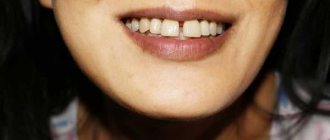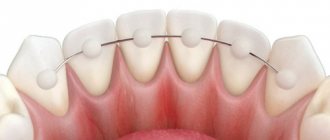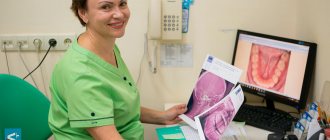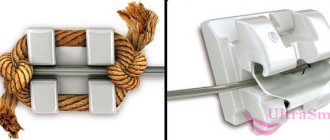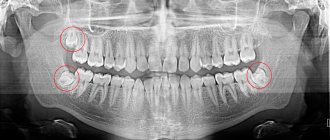This is a headache and a nightmare for any orthodontist: a patient who has had his braces removed and given a removable retainer and instructions for its use returns after some time with complaints about the curvature of his previously straight teeth. The retention period is the most psychologically difficult part of the treatment. Everything is already perfect, and then you have to wear a retainer. Yes, there are other reasons for the unsuccessful outcome of the correction. And although they are much less common, let’s talk about them in more detail.
Correction principle
The method of correcting malocclusion with braces is based on the principle of creating constant pressure on the teeth. Under pressure, the tooth root begins to press on the socket on one side, thereby causing rarefaction of the bone tissue. In the direction of rarefaction, the tooth moves. On the other side of the hole, bone tissue, on the contrary, grows. Thus, after a certain period of time, not only the position of the tooth changes, but also the shape of the socket, which prevents the tooth from returning to its original place.
Correct your bite or dental defect with invisible aligners Find out what it is
Bone tissue grows quite quickly, but it takes quite a long time to “ripen”. That is why, after finishing wearing the brace system, a removable retainer is made for the patient for another year or two or a splint is installed on the incisors and canines. Additional fixation during the retention period helps to avoid repeated tooth curvature.
How often should inspections be carried out?
Every 1-2 months, it all depends on the defect and the individual structure of the patient’s teeth. During the visit, the orthodontist checks the success of the treatment and sets a vector for the arch, which determines the movement of teeth in the right direction.
Missing follow-up visits may negate the effect of previous treatment. You are also required to visit a hygienist every six months.
Braces, whether external or internal, need to be worn for an average of 1.5 years. But determining more precise timing depends on the initial situation and age of the patient. Sometimes it takes 2 years to eliminate a defect.
Possible problems after removing braces
Some people's teeth diverge quickly after completing the correction stage. During the first year, some individuals may only slightly rotate around their axis. Everything is individual, but some general patterns can be identified.
Fanned teeth
A rapid relapse after braces are removed may be due to the following factors:
- Refusal of retainers. Patients often refuse permanent retainers because their installation damages tooth enamel. And it’s annoying to wear removable retainers, even those that are worn only at night. As a result, the teeth return to their previous position, since the new position has not yet been “overgrown” with bone tissue.
- Individual characteristics. There are people in whom new formation and “maturation” of bone tissue proceeds faster than others. And there are those for whom this process is delayed. For some, the displacement of teeth in order to correct the shape of the dentition was insignificant, while for others the tooth “came a long way” before taking its place in the dentition. Teeth quickly “huddle together” after crowding is eliminated. The teeth, which were mixed with braces around their axis, easily turn back.
- Breakage of braces, use of a system of inadequate quality. If the pressure on the teeth during correction was not constant, then the likelihood of an unfavorable outcome increases. You shouldn’t walk around with a broken arch or unstuck locks for a week. It is better to see a doctor on the same day. This will save you from many problems.
- Tooth extraction. When there is not enough space for teeth in the dentition, the orthodontist may decide to remove the “extra” ones. Most often these are fours, eights, less often sixes. The absence of fangs can cause the formation of a diastema. Removing a six causes significant displacement of adjacent teeth.
Loose teeth after braces
Occurs infrequently. In most cases, the feeling of excessive tooth mobility after removing braces is deceptive. It may appear at the very beginning of the retention period and disappear on its own and without treatment. It's another matter if the teeth are really loose. In this case, it is better to seek help from a specialist.
Pain in the teeth and gums
There may be some discomfort after removing braces. Pain occurs especially often after eating solid foods. The reason for this is a change in the condition of the ligaments that hold the roots of the teeth, as well as an increase in the sensitivity of the enamel if the remineralization procedure was not carried out. Reducing the chewing load and using special medications that reduce the sensitivity of teeth and gums help reduce pain.
What to do if your teeth are crooked
If the curvature is too severe, braces will likely need to be reinstalled. If the defect is minor, you can get by with regular retainers. In any case, if the slightest changes are detected in the oral cavity, the patient should immediately seek advice from his doctor.
There are situations when, even after installing a mouth guard or wire, the teeth still move apart. This is due to incorrect position or an error in the manufacture of the model. But, unfortunately, most often this happens due to the fault of the patient at the dental clinic.
Tired of wearing bulky orthodontic appliances, a person feels freedom and stops monitoring the condition of his teeth. He may forget to wear a mouthguard, not pay due attention to oral hygiene, etc. All this can lead to complications: the appearance of caries, inflammation, as well as displacement of units to their usual position. It is very important to follow all the recommendations of the doctor, who, after dismantling the structure, will definitely prescribe the use of a specific retainer, toothpastes, strengthening compounds, brushes of optimal hardness, etc.
Rules for wearing retainers
In order to prevent the reverse process of correcting the bite, you should strictly follow all the rules for wearing an orthodontic appliance:
- Don't take on the role of a specialist and stop wearing removable braces on your own. Only an orthodontist can determine the duration of the retention period. This question takes into account the patient’s age, genetic predisposition, and individual characteristics of the oral cavity.
- During hygiene procedures when operating a fixed device, the set of necessary tools should be expanded. In addition to a toothbrush, it is recommended to use special brushes and dental floss.
- Plastic aligners should be removed from the mouth before each meal , otherwise they may become deformed during the chewing process.
- As an additional oral care product, it is worth using a fluoride-containing rinse , which will strengthen the structure of tooth enamel.
Professional cleaning is recommended at least twice a year.
Types of aesthetic braces, their advantages and disadvantages.
In this publication, we will look at methods for treating crowded teeth without braces.
Follow the link https://orto-info.ru/ortodonticheskoe-lechenie/osnovnoy-period/operatsiya-radikalnoe-ispravlenie-defektov.html if you are interested in the price of orthognathic surgery.
Causes
In young children, distal occlusion is a physiological norm. The upper jaw protrudes above the lower jaw by a distance of 1 to 10 mm. This is necessary for sucking the mother's breast. Gradually, the distal bite becomes orthognathic.
Reasons for the development of prognathia:
- Vitamin D deficiency. Causes rickets at an early age, the consequence of which is distal or mesial occlusion.
- Premature loss of baby teeth or their removal.
- Genetic factor.
- Calcium and fluoride deficiency in the body of a pregnant woman causes prognathism in the child.
- The influence of external factors - the use of a pacifier, sucking of fingers and other objects in childhood.
- Chronic pathologies of the respiratory system, causing disruption of normal nasal breathing. This leads to improper jaw development.
- Poor posture. A bent back and a head down provoke the development of jaw pathology.
- Injuries that damage the jaw bones.
- Some types of speech defects, due to which distal occlusion develops.
Is it possible to change the situation?
1. If desired, bringing your smile to perfection will not be difficult and will not always require significant investments. After all, the first, most important, most necessary stage has already been completed. Orthodontic treatment corrects your bite, straightens your teeth, and prevents more serious dental problems. And modern methods of artistic (or aesthetic) dental restoration will help restore the aesthetics of the dentition.
2. Adults are able to solve the dilemma themselves: whether to continue treatment if they don’t quite like the smile, or limit themselves to the achieved result.
Signs of pathology
Incorrect distal bite is conventionally divided into 2 types based on its characteristics. These are facial and intraoral changes. Their most severe severity is observed in adults in the complete absence of treatment.
Facial manifestations of distal occlusion:
- Violation of facial proportions - asymmetrical displacement of the lower jaw back and a small, sloping chin.
- A noticeable state of always half-open mouth.
- Change in the natural shape of the upper lip - reduced in volume, upturned or very short.
- Deformation of the lower lip.
- The teeth of the upper jaw are more developed than the lower jaw, the central upper incisors protrude strongly forward.
- Sharply defined chin fold.
Such changes in the shape of the face negatively affect the appearance, the face becomes bird-like.
Intraoral signs of a distal anomaly are as follows:
- There is no closure between the lower and upper jaw.
- The teeth of the upper frontal group are noticeably moved forward.
- The lateral teeth are located abnormally relative to each other.
In most cases, distal occlusion is formed against the background of other pathologies - diastema, trema, open or crossbite.
Classification of pathology
The following types of prognathic occlusion are distinguished:
- First type. Characterized by underdevelopment of the lower jaw. At the same time, the upper one, in its anatomical structure, develops in accordance with age.
- Second type. It is characterized by excessive development of the upper jaw along with the teeth, while the lower one is formed normally.
- Third type. In this case, changes of the first two types are combined.
- Fourth type. Involves the advancement of the front teeth of the upper jaw, which is insignificant.
Orthodontists also use the Angle classification of prognathia:
- 2 class 1 subclass. It is characterized by a narrowing of the dentition on the sides, and the front teeth of the upper jaw are fan-shaped. There is a sagittal fissure.
- 2nd class 2nd subclass. The lateral teeth are turned along their axis and deviate towards the lips, the upper front teeth tilt towards the palate. There is no sagittal fissure.
What complications can there be?
If an adult or child has developed a distal bite, treatment will help avoid the consequences of pathology. In the absence of correction, the following complications are possible, which are dangerous to health:
- problems with diction, speech defects arise, correctly constructed speech becomes impossible;
- dysfunction of chewing and swallowing food;
- disruption of the proper functioning of the respiratory system;
- the appearance of dental diseases - caries and stomatitis develop;
- rapid wear of teeth, which leads to their premature loss;
- the formation of complexes due to unsightly appearance.
Malocclusion affects a person’s entire life, causing psychological problems and the development of an inferiority complex. People with this problem are often unhappy and lack self-confidence. Only correction will help improve your condition and appearance.
